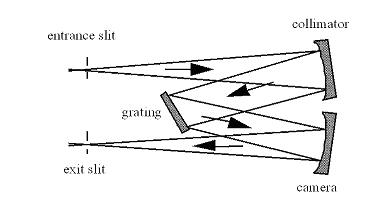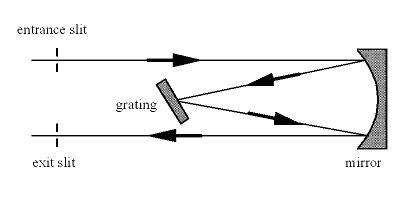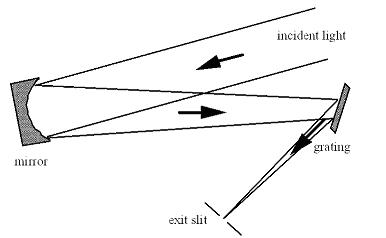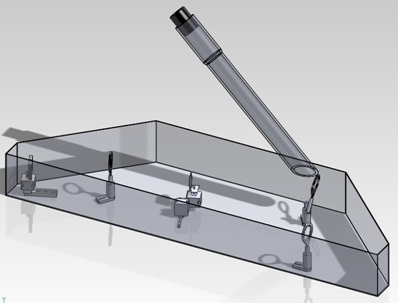Physical Design
With a monetary cap of $2000 for the entire spectrograph assembly, we must be very purposeful in our design. For example, we decided to pursue a monochromator design for its ease of implementation. This simplicity limits the number of components, allowing for higher quality equipment to be purchased. The three basic monochromator designs discussed are as follows.

Figure 1: The Czerny-Turner Monochromator

Figure 2: The Ebert-Fastie Monochromator

Figure 3: The Monk-Gillieson Monochromator
Figures and Information from: Palmer, Christopher. Diffraction Grating Handbook. 6th ed. New York: Newport Corporation, 2005. Print.
The Czerny-Turner Monochromator utilizes two mirrors: one to collimate the light and another to focus it onto the detector (Fig. 1). The smaller optics allow us to reduce prices and obtain a higher resolution. However, it may be difficult to properly align these optical devices yielding erroroneous results. The advantage of the Ebert-Fastie Monochromator is that it uses one mirror to collimate the light and focus it onto the detector (Fig. 2). This prevents the need to adjust two separate mirrors, thereby reducing discrepancies. The downfall of this design is that these large optical components tend to become very expensive. The simplest design we looked at was the Monk-Gillieson Monochromator (Fig. 3). Its simplicity would make it cheap and relatively easy to build, but it would not be able to provide high enough resolution for the experiment we wish to perform.
Any experiment performed by these designs rely on the accurate positioning of the diffraction grating. This high degree of precision can be obtained through rotary stepper motors. The greater the degree of accuracy we can attain, the more involved experiments we can perform. In addition to money limiting the selection of a motor, we will have to take into account that we only have 90 minutes to perform our experiment. Thus the motor must be quick enough to enable all necessary calculation to be made in this time. Other components to be considered are photodetectors, pinholes, lenses, and various electrical components.

Above is a three dimensional model of the spectrograph as designed by Team Dark Star. The spectrograph's goal is to measure atmospheric absorption. As specific molecules only interact with certain wavelengths of light, atmospheric absorption tells many things about the composition of the air in a specific region. The spectrograph is designed to collect data across the entire visible spectrum from 400 nm - 1000 nm. In order to increase resolution, a slit will be placed in the imaging plane of the incident lens. All measurements will be the average of 10 individual tests in order to reduce noise. At this point the data will be compared to the theoretical black body and the differences will be noted as absorption features. From here the composition of the air may be examined. In the spirit of the competition, design specifications will be withheld until closer to the competition date.
